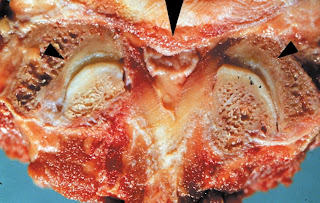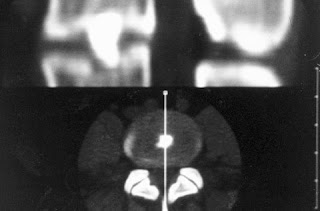Saturday, May 9, 2009
Acute trauma, either in the form of a direct blow to the spine or the application of excessive rotational or compressive force applied to the spine, can result in injury to virtually any structure. The structures most vulnerable to acute trauma are the annulus fibrosus of the intervertebral discs, the endplates of the intervertebral discs and the vertebral bodies.
DISC HERNIATION
When compressive or rotational forces are applied to the spine, the fibers of the annulus fibrosus can be stretched beyond their elastic capacity and tear. If these tears are oriented in a radial fashion, the nucleus pulposus may migrate through the tear, causing a protrusion of the disc beyond its natural borders. This can occur as an acute process in a healthy disc given sufficient force. Degenerated discs that already have some degree of annular tearing, usually in a circumferential pattern, have less elastic proteoglycans and are less able to withstand these forces. If there is a disruption of the posterior longitudinal ligament, nuclear material can extrude through the annulus, narrowing the diameter of the
Transverse section at the L5–S1 level showing a disc herniation centrally encroaching on the central canal, causing stenosis. Courtesy Churchill-Livingstone (Saunders) Press
One variety of vertebral body and endplate defect allowing herniation of the nucleus pulposus into the vertebral body.
(a) MRI TI weighted image revealed herniation of the L3–L4 disc into the L3 body, creating a ‘Schmorl's node’ or ‘Geipel hernia’;
(b) the same
patient's T2 weighed image;
(c) post-discogram computed tomography sagittal reformation demonstrating a ‘Schmorl's node’
Label: Doctor Pedeatric, Dokter Anasthesi, Dokter Care
